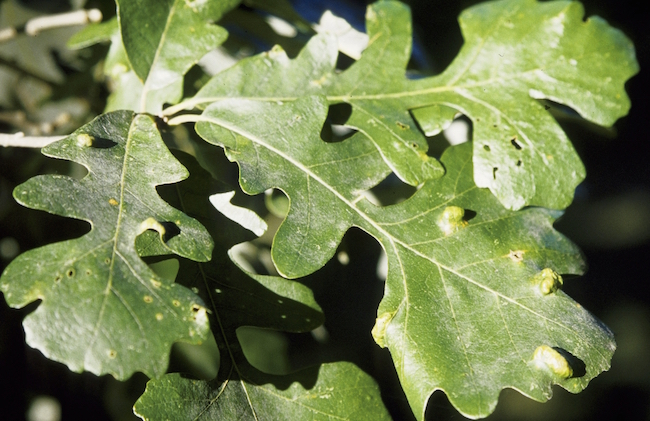All of the rain earlier this spring has resulted in numerous calls to University of Georgia Cooperative Extension agents about leaf spot diseases on a variety of plants, including oak trees.
Most fungal pathogens that infect leaves prefer cool, moist conditions during leaf expansion in early spring. As young, tender leaves begin to expand in the spring, they are more susceptible to infections caused by these types of diseases.
Most leaf spot diseases are very host-specific, meaning they will only affect one type of plant or a related plant family. Generally, a disease is not going to move from an oak tree to a maple tree or any other unrelated trees.
The leaf spot disease seen most often on oak trees this year is caused by a fungus known as Taphrina caerulescens, or oak leaf blister. This disease commonly occurs on most oak species.
The fungus only infects young emerging leaf tissue in the spring. The spores of the fungus form on the leaf surface, are blown to new buds and remain dormant there until the next spring. The fungus has only one infection period in the spring and does not continue to cause new spots later.
The spots start out as small and inconspicuous, with quarter-inch lesions turning light green on young leaves. Cells in the spots multiply more than surrounding cells and result in a raised, blister-like buckling of the leaf later in the season.
As the spots age, their upper surfaces become covered with a buff-white coating of fungal growth that later turns brown. The leaves remain on the tree and usually do not fall prematurely. In extreme cases, the leaves may appear to be dead or dying.
Fungicide applications are not necessary because the leaf spots are rarely severe and the leaves can still function. Although infections may be extensive in some years, little damage actually results.
This is one of those plant diseases that appears worse than it actually is. Fungicide applications won’t cure the disease once the spots have formed on the leaves.
Also, from a practical standpoint, fungicides are difficult to apply to large trees. For small trees, fungicides containing mancozeb or chlorothalonil can be applied to prevent spotting, but must be applied prior to and during bud break, when dormant buds open and shoots begin to grow, in early spring. Once bud break has occurred and symptoms are visible, it’s too late to spray.
Several other leaf spot diseases also affect oak trees later in the growing season. The good news is that oak leaf blister and other leaf spot diseases will not kill a tree that is otherwise healthy. If a tree dies during the summer, it’s more likely because of drought stress, root damage or other issues not related to a leaf spot disease.
Keep trees healthy by providing supplemental water during extreme drought conditions, adding mulch to the root zone to conserve water and avoiding mechanical equipment injuries to the roots or trunks.
Healthy trees tolerate leaf spot diseases better over the long term. Also, large trees should be pruned by a professionally licensed, certified arborist to avoid permanent tree damage and stress.
UGA Extension recommends hiring an International Society of Arboriculture (ISA)-certified arborist for any type of tree maintenance tasks. Search for a certified arborist by location/postal code at www.isa-arbor.com/findanarborist/findanarborist.aspx.








